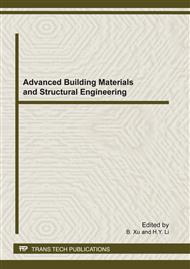[1]
Firman, T.: Rural to urban land conversion in Indonesia during boom and bust periods. Land Use Policy, 17, 13-20 (2000).
DOI: 10.1016/s0264-8377(99)00037-x
Google Scholar
[2]
Taipei City Government Information on http: /www. uro. taipei. gov. tw.
Google Scholar
[3]
Wu, F.: Re-orientation of the city plan: Strategic planning and design competition in China. Geoforum, 38, 379-392 (2007).
DOI: 10.1016/j.geoforum.2006.05.011
Google Scholar
[4]
Yigitcanlar, T. O'Connor, K. Westerman, C.: The making of knowledge cities: Melbourne's knowledge-based urban development experience. Cities, 25, 63- 72 (2008).
DOI: 10.1016/j.cities.2008.01.001
Google Scholar
[5]
Taipei City Government Information on http: /www. beautiful. taipei. gov. tw.
Google Scholar
[6]
Adams, D. Hastings, E.M.: Urban renewal in Hong Kong: transition from development corporation to renewal authority. Land Use Policy, 18, 245-258 (2001).
DOI: 10.1016/s0264-8377(01)00019-9
Google Scholar
[7]
Myllyla, S. Kuvaja, K.: Society premises for sustainable development in large southern cities. Global Environmental Change, 15, 224-237 (2005).
DOI: 10.1016/j.gloenvcha.2005.01.001
Google Scholar
[8]
Chan, EH.W. Yung, EH.K.: Is the development control framework conducive to a sustainable dense urban development in Hong Kong? Habitat International, 28, 409-426 (2004).
DOI: 10.1016/s0197-3975(03)00040-7
Google Scholar
[9]
Juan Y.K. Gao, P. Wang, J.: A hybrid decision support system for sustainable office building renovation and energy performance improvement. Energy and Buildings, 42, 290-297 (2010).
DOI: 10.1016/j.enbuild.2009.09.006
Google Scholar
[10]
Taipei City Government Information on http: /www. udd. taipei. gov. tw.
Google Scholar
[11]
Taipeo City Government Information on http: /www. uri-taipei. org.
Google Scholar
[12]
Juan, Y.K. Shih, S.G. Perng, Y.H.: Decision support for housing customization: A hybrid approach using case-based reasoning and genetic algorithm. Expert Systems With Applications, 31, 83-93 (2006).
DOI: 10.1016/j.eswa.2005.09.010
Google Scholar
[13]
Wu, J. Barnes, T.: Local planning and global implementation: Foreign investment and urban development of Pudong, Shanghai. Habitat International, 32, 364-374 (2008).
DOI: 10.1016/j.habitatint.2007.11.003
Google Scholar
[14]
Taipei City Government Information on http: /english. taipei. gov. tw.
Google Scholar
[15]
Chang, C.R. Li, MH. Chang, S.D.: A preliminary study on the local-island intensity of Taipei city parks. Landscape and Urban Planning, 80, 386-395 (2007).
DOI: 10.1016/j.landurbplan.2006.09.005
Google Scholar
[16]
Alexander, J.: The educational buildings of Pius IV: variations upon a building type in urban monuments. Landscape and Urban planning, 73, 89-109 (2005).
DOI: 10.1016/j.landurbplan.2004.11.002
Google Scholar
[17]
Al-Hathloul, S. Mughal, MA.: Creating identity in new communities: case studies from Saudi Arabia. Landscape and Urban Planning, 44, 199-218 (1999).
DOI: 10.1016/s0169-2046(99)00010-9
Google Scholar
[18]
Nagashima, K. Sands, R. Whyte, A.G.D. Bilek, E.M. Nakagoshi, N.: Regional landscape change as a consequence of plantation forestry expansion: an example in the Nelson region, New Zealand. Forest Ecology and Management, 163, 245-261 (2002).
DOI: 10.1016/s0378-1127(01)00583-7
Google Scholar
[19]
Waley, P.: Parks and landmarks: planning the Eastern Capital along western lines. Journal of Historical Geography, 31, 1-16 (2005).
DOI: 10.1016/j.jhg.2003.10.001
Google Scholar
[20]
International Urban Development Association Information on http: /www. inta-aivn. org/en.
Google Scholar
[21]
Heide,M. Lardal, K. Gronhaug, K.: The design and management of ambience—Implications for hotel architecture and service. Tourism Management, 28, 1315-1325 (2007).
DOI: 10.1016/j.tourman.2007.01.011
Google Scholar
[22]
Moropoulou, A. Tsiourva, Th. Bisbikou, K. Tsantila, V. Biscontin, G. Longege, G. Groggia, M. Dalaklis, E. Petritaki, A.: Evaluation of cleaning procedures on the facades of the Bank of Greece historical building in the center of Athens. Building and Environment, 37, 753-760 (2002).
DOI: 10.1016/s0360-1323(01)00058-0
Google Scholar
[23]
Kumar, R. Sachdeva, S. Kaushik, S.C.: Dynamic earth-contact building: A sustainable low-energy technology. Building and Environment, 42, 2450-2460 (2007).
DOI: 10.1016/j.buildenv.2006.05.002
Google Scholar
[24]
Spala, A. Bagiorgas, H.S. Assimakopoulos, M.N. Kalavrouziotis, J. Matthopoulos, D. Mihalakakou, G.: On the green roof system. Selection, state of the art and energy potential investigation of a system installed in an office building in Athens, Greece. Renewable Energy, 33, 173-177 (2008).
DOI: 10.1016/j.renene.2007.03.022
Google Scholar


